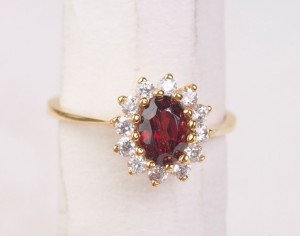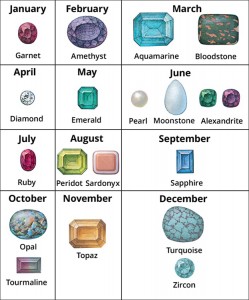Rubies of July
Friday, July 5th, 2019July 5, 2019
If your birthday is in July, your birthstone—the gem associated with the month of your birth—is the beautiful and valuable ruby. A red gem variety of the mineral corundum, rubies are called sapphires if they are any color other than red. Since ancient times, rubies have been treasured for their beauty as well as their symbolic value in folklore, religion, and superstition.

The ruby, the birthstone for July, is often used to make jewelry such as rings. This ring is set with a ruby and diamonds. Credit: © JupiterMedia/Alamy Images
Early cultures valued rubies for their resemblance in color to human blood, and the gems were thought to hold the power of life. Rubies were later associated with beauty, love, passion, wealth, and wisdom. Ancient Sanskrit texts refer to the ruby as “the king of precious stones,” and Hindu legend says that those who offered rubies to the god Krishna were granted rebirth as emperors. Rubies were thought to protect those who wore them, even bestowing invincibility in battle. It was not enough to simply wear rubies, however—they were often inserted in the skin. Rubies were also sometimes included in the foundations of buildings to ensure good fortune. Rubies have long adorned earrings, necklaces, rings, and other jewelry, and they are the traditional gift for a 40th wedding anniversary.
Chemically, a ruby is an aluminum oxide. Rubies get their color from traces of chromium. The red of most rubies has a brownish or yellowish tint. The rarest, most highly prized rubies are pure “pigeon-blood red.” Rubies and sapphires are second only to diamonds in hardness, and fine-quality rubies are among the costliest of all gems. The finest rubies come from Myanmar. Other primary producers of rubies are Cambodia, Kenya, Madagascar, Tanzania, Thailand, and Zimbabwe.
A star ruby cabochon shows a six-rayed star within it when seen in a bright light. A cabochon is a rounded, polished stone. The largest known natural ruby, named the “Eminent Star,” weighs 6,465 carats, or almost three pounds (1.36 kilograms). Millions of carats of inexpensive synthetic rubies are made each year. But a demand for real gems has allowed the natural stones to maintain their high value. It can be hard to distinguish between natural and synthetic rubies, even for experts. Experts are also challenged when determining whether the color of a natural ruby has been improved by heating.
According to tradition, a birthstone brings good luck to a person born in its month. Each birthstone also corresponds to a sign of the zodiac. The belief in birthstones may have come from a Bible story about Aaron, the first high priest of the Israelites. The story describes Aaron’s breastplate, which was decorated with 12 precious stones. Early writers linked these stones with the 12 months of the year and the 12 signs of the zodiac. The custom of wearing a stone that represented a person’s zodiac sign probably originated in Germany or Poland in the 1700′s.



